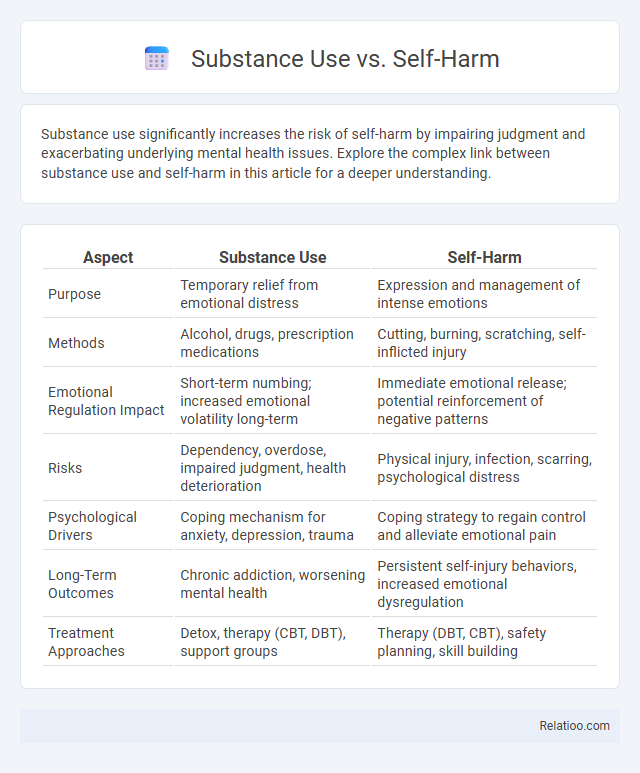Substance use significantly increases the risk of self-harm by impairing judgment and exacerbating underlying mental health issues. Explore the complex link between substance use and self-harm in this article for a deeper understanding.
Table of Comparison
| Aspect | Substance Use | Self-Harm |
|---|---|---|
| Purpose | Temporary relief from emotional distress | Expression and management of intense emotions |
| Methods | Alcohol, drugs, prescription medications | Cutting, burning, scratching, self-inflicted injury |
| Emotional Regulation Impact | Short-term numbing; increased emotional volatility long-term | Immediate emotional release; potential reinforcement of negative patterns |
| Risks | Dependency, overdose, impaired judgment, health deterioration | Physical injury, infection, scarring, psychological distress |
| Psychological Drivers | Coping mechanism for anxiety, depression, trauma | Coping strategy to regain control and alleviate emotional pain |
| Long-Term Outcomes | Chronic addiction, worsening mental health | Persistent self-injury behaviors, increased emotional dysregulation |
| Treatment Approaches | Detox, therapy (CBT, DBT), support groups | Therapy (DBT, CBT), safety planning, skill building |
Understanding Substance Use: Definitions and Types
Substance use refers to the consumption of psychoactive substances such as alcohol, illicit drugs, or prescription medications, which can vary in frequency and intensity from experimental to habitual use. It is distinct from self-harm, which involves intentional injury to oneself without suicidal intent, and harmful coping, which encompasses maladaptive behaviors used to manage stress. Understanding the types of substance use--ranging from casual use to substance use disorder--helps clarify its role in mental health and differentiate it from behaviors like self-injury or unhealthy coping mechanisms.
What Constitutes Self-Harm? Forms and Behaviors
Self-harm refers to deliberate behaviors intended to cause physical injury to oneself without suicidal intent, such as cutting, burning, or hitting. These actions serve as a maladaptive coping mechanism to manage emotional pain, stress, or trauma, distinguishing them from substance use, which often involves dependency and intoxication. Understanding these behaviors helps you recognize harmful coping strategies and seek healthier alternatives.
Key Differences Between Substance Use and Self-Harm
Substance use involves consuming drugs or alcohol to alter mood or behavior, often leading to addiction and physical health issues, while self-harm refers to deliberately inflicting injury on oneself to cope with emotional pain without suicidal intent. Harmful coping mechanisms encompass both behaviors but also include other destructive strategies like avoidance or aggression that negatively impact well-being. Understanding these key differences helps you recognize that substance use harms through external chemical dependence, whereas self-harm directly damages the body as a form of emotional relief.
Common Psychological Triggers and Motivations
Substance use, self-harm, and harmful coping behaviors often stem from shared psychological triggers such as intense emotional distress, trauma, and feelings of helplessness. Individuals may engage in these actions to manage overwhelming negative emotions or to gain temporary relief from anxiety, depression, and stress. Underlying motivations frequently include a desire for control, escape from psychological pain, and a maladaptive attempt to self-soothe or communicate internal struggles.
Overlapping Risk Factors and Vulnerable Populations
Substance use, self-harm, and harmful coping share overlapping risk factors such as trauma exposure, mental health disorders, and social disadvantage, which exacerbate vulnerability in populations including adolescents, individuals with a history of abuse, and those experiencing socioeconomic hardships. Co-occurrence of these behaviors often reflects underlying maladaptive coping mechanisms triggered by stress, emotional dysregulation, and genetic predispositions. Targeted interventions addressing these shared risk factors in high-risk groups are essential for prevention and effective treatment outcomes.
Warning Signs: Identifying Substance Use vs Self-Harm
Warning signs for substance use include sudden changes in behavior, physical symptoms like bloodshot eyes or frequent nosebleeds, and neglect of responsibilities. Self-harm indicators often involve unexplained cuts, bruises, or burns, along with signs of emotional distress or withdrawal from social interactions. Differentiating harmful coping mechanisms requires careful observation of physical evidence, psychological state, and contextual factors to provide effective intervention.
Short-term and Long-term Consequences
Substance use often leads to short-term consequences such as impaired judgment, accidents, and immediate health risks, while long-term effects include addiction, organ damage, and mental health disorders. Self-harm primarily results in immediate physical injuries and emotional relief, but over time it can cause chronic wounds, increased risk of infection, and worsening psychological distress. Harmful coping strategies might temporarily reduce stress, yet they frequently contribute to prolonged emotional instability, relationship breakdowns, and diminished life quality.
Effective Intervention and Treatment Approaches
Effective intervention and treatment approaches for substance use, self-harm, and harmful coping focus on evidence-based therapies such as Cognitive Behavioral Therapy (CBT), Dialectical Behavior Therapy (DBT), and Medication-Assisted Treatment (MAT) tailored to individual needs. You benefit from integrated care plans that address underlying mental health conditions, trauma, and behavioral patterns to reduce relapse and promote long-term recovery. Collaborative support involving healthcare providers, counselors, and peer support systems enhances treatment adherence and emotional resilience.
Supporting Loved Ones: How to Help
Supporting loved ones struggling with substance use, self-harm, or harmful coping involves recognizing the distinct underlying causes and responding with empathy and appropriate resources. Encouraging professional treatment options such as therapy, counseling, and support groups tailored to addiction or mental health challenges strengthens recovery outcomes. Maintaining open communication and setting healthy boundaries fosters a safe environment that facilitates healing and resilience.
Prevention Strategies and Building Resilience
Effective prevention strategies for substance use, self-harm, and harmful coping involve early identification of risk factors, promoting emotional regulation, and fostering strong social support networks. Building resilience in individuals includes enhancing problem-solving skills, encouraging healthy coping mechanisms, and providing access to mental health resources tailored to Your specific needs. These approaches collectively reduce vulnerability and support long-term psychological well-being.

Infographic: Substance Use vs Self-harm
 relatioo.com
relatioo.com